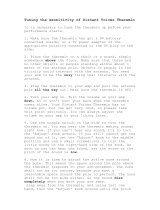11. Only use attachments/accessories specified by the manufacturer.
12. Use only with the cart, stand, tripod, bracket, or table specified by the
manufacturer, or sold with the apparatus. When a cart is used, use
caution when moving the cart/apparatus combination to avoid injury
from tip-over.
13. Unplug this apparatus during lightning storms or when unused for
long periods of time.
14. Refer all servicing to qualified service personnel.Servicing is required
when the apparatus has been damaged in any way, such as power
supply cord or plug is damaged, liquid has been spilled or objects
have fallen into the apparatus, when the apparatus has been exposed
to rain or moisture, does not operate normally, or has been dropped.
15. To completely disconnect this apparatus from the AC mains,
disconnect the power supply cord plug from the AC receptacle.
16. WARNING: To reduce the risk of fire or electric shock, do not expose
this apparatus to rain or moisture.
17. Do not expose this equipment to dripping or splashing and ensure
that no objects filled with liquids, such as vases, are placed on the
equipment.
18. The mains plug of the power supply cord shall remain readily accessi-
ble.
Installation
• Ensure that the room in which you use this product is wired in accordance
with the local electrical code and checked by a qualified inspector.
• Only use this product indoors.
• Do not install the product in hot, humid, or excessively dusty locations, in
direct sunlight or in locations where it is exposed to externally generated
vibrations.
• Do not place burning objects (e.g. candles) on top of or near the product.
• If condensation has formed on the product, e.g. because it was moved
from a cold environment to a warm one, allow the product to acclimatize
to room temperature before using it.
• Do not overload wall outlets and extension cables as this may result in
fire and electric shock.
Owner's Manual VERMONA Filter Lancet
























